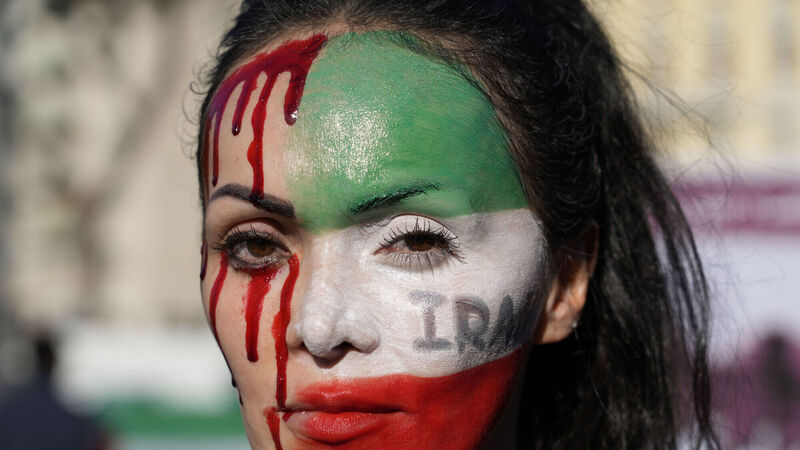Maeve Higgins: Broad strokes are unhelpful when the stakes are so high in Iran

A woman at a protest against the death of Mahsa Amini. Photo: AP/Gregorio Borgia
Successful revolutions don’t happen overnight, except when they do. Trying to predict when a regime might topple might be an interesting intellectual question to puzzle over from a distance, but what is it like to live through that struggle, to try to effect change, or try to prevent it?
Iranians are living through that right now and have been since the death of Mahsa (Jina) Amini in state custody. Her death, caused by the brutality inflicted by the so-called ‘morality police’, set off a wave of protests three months ago. At least 488 people have been killed since mid-September, according to Human Rights Activists in Iran, an NGO monitoring the protests, who also report that authorities have detained up to 18,200 people.
This past week, two young men were executed for their role in the protests. Their trials were brief, held in private, and utterly devoid of anything resembling justice.
One of them, Majidreza Rahnavard, had been accused of killing two members of the paramilitary Basij force. He was executed publicly in the city of Mashhad, a centre of the protests. Photographs of the 23-year-old’s dead body were disseminated, with hands and feet tied, hanging from a crane with a bag over his head.
At least 11 other protesters have been sentenced to death, according to Amnesty International. It is a clear and terrifying message to protestors and those who would join them. How is that message being received?
It’s not possible or advisable to generalise how 86 million people of various ethnicities, religions, and cultures are feeling at this tumultuous moment. Reza H. Akbari is an Iranian-American analyst and program manager at the Institute for War and Peace Reporting in Washington D.C., and he’s been closely watching the reaction to the executions.
He said:
Opposition figures, human rights advocates, protesters, athletes, and celebrities have expressed a strong sense of outrage. There is shock, dismay, and devastation.
"Regime supporters, however, may feel more ambivalent since the judiciary accused these protesters of committing murder.”
The families of the men from the security forces killed during protests have been demanding justice. But a hasty, secretive trial and a public execution are clearly not due process. No matter what, Akbari says the process was rushed and unjust. “I think state officials are trying to send a strong message rather than wanting to deliver true justice to anyone.”
Time Magazine named ‘The Women of Iran’ as their 2022 Heroes of The Year, featuring a photo of three women standing defiantly with their heads uncovered, wearing clothes that don’t abide by the strict dress code of the Islamic State.
The headscarf became one of the symbols used by protestors to express their anger and anguish over Mahsa Amini’s death; she was initially taken by the ‘morality police’ because they decided she was not correctly wearing her hijab. Last week, a government spokesman announced that the morality police had been abolished.
That looks like a concession, of course, but laws about how women must dress, including mandatory hijab and loose clothes, remain the same as before the protests. What remains to be seen is how much and in what ways the government will enforce those laws.

“It comes down to freedom of choice, but realising that goal is a complex process. An unjust law is taking away the right for women to choose how they want to express themselves.”
In opposition to the law, Akbari explains, some women in larger cities had, even before these latest protests, started to take the grave risk of simply not wearing hijab. Since the protests, many more have joined them.
He continues: “Other factors also influence individuals’ ability to make a choice, however. Depending on their geographical location in the country, their neighborhood, and family values, some women may be hindered by or prefer to abide by existing conservative cultural and social norms.” Every woman’s decision is rooted in more than the law alone.
Authoritarian regimes like the one headed up by Ayatollah Ali Khamenei, the country’s supreme leader since 1989, do not quickly back down, and when forced to, they do so as quietly as they can. Akbari told me about one such muted u-turn.
For many years, the authorities searched for and confiscated satellite dishes from peoples’ homes across Iran; satellite dishes were banned. But the people kept replacing them, and eventually, the authorities left the satellite dishes alone. Akbari told me:
It was a silly battle that they launched and lost really quickly. And the law never changed; there was never a statement by anyone saying satellite dishes are no longer illegal or the law will no longer be enforced; they just stopped enforcing it.
The stakes are higher now than they ever were about satellite dishes. As we have seen so tragically, the stakes are life and death. But Akbari point outs the layers in this complicated story and is keen to avoid the broad strokes he sees in many depictions of a simple ‘state vs. people’ struggle. Like all our states, the Iranian State is made up of people and won’t simply vanish after a potential revolution.
“The country has a 200-year history of expanding bureaucratic institutions. There are millions of government employees, so it’s not just a handful of geriatric turbaned gentlemen that we often see on TV that are running the place.”
He continues: “Hopes that the youth will inevitably bring about progressive change are not guaranteed because youth are not a monolith. The sad truth is that most of the baton-wielding security forces are also very young.”
Somehow, even during these frightening and unpredictable times, the people of Iran keep their sense of humour and humanity intact. The day the government announced an end to the morality police, a photo did the rounds of social media. It was a neon sign beaming “Hosseini’s Kebab House, formerly known as Hosseini’s Kebab House.” The photo was captioned “Morality Police Abolished”.
Change is always possible, and it’s often promised, but Iranians know more than most that real change does not always happen quickly and rarely happens easily.

Subscribe to access all of the Irish Examiner.
Try unlimited access from only €1.50 a week
Already a subscriber? Sign in
CONNECT WITH US TODAY
Be the first to know the latest news and updates










